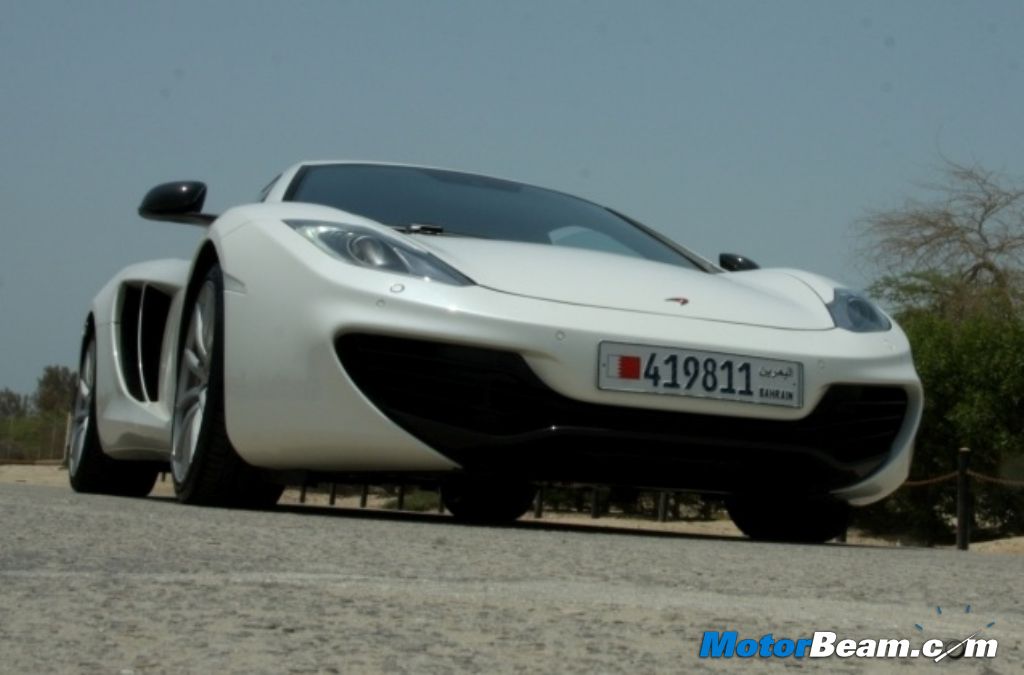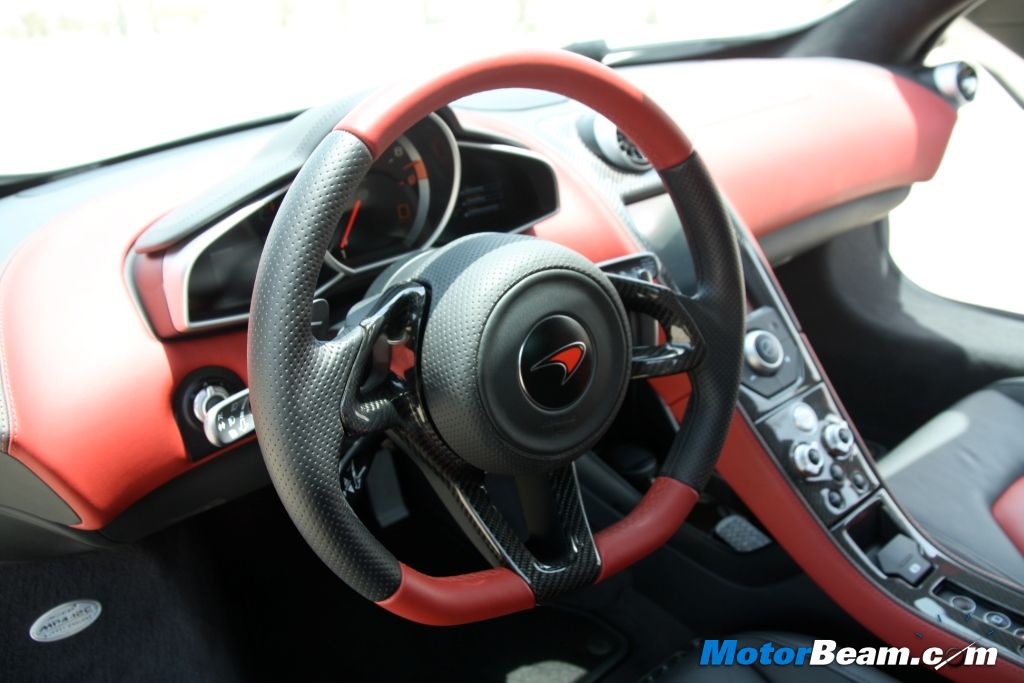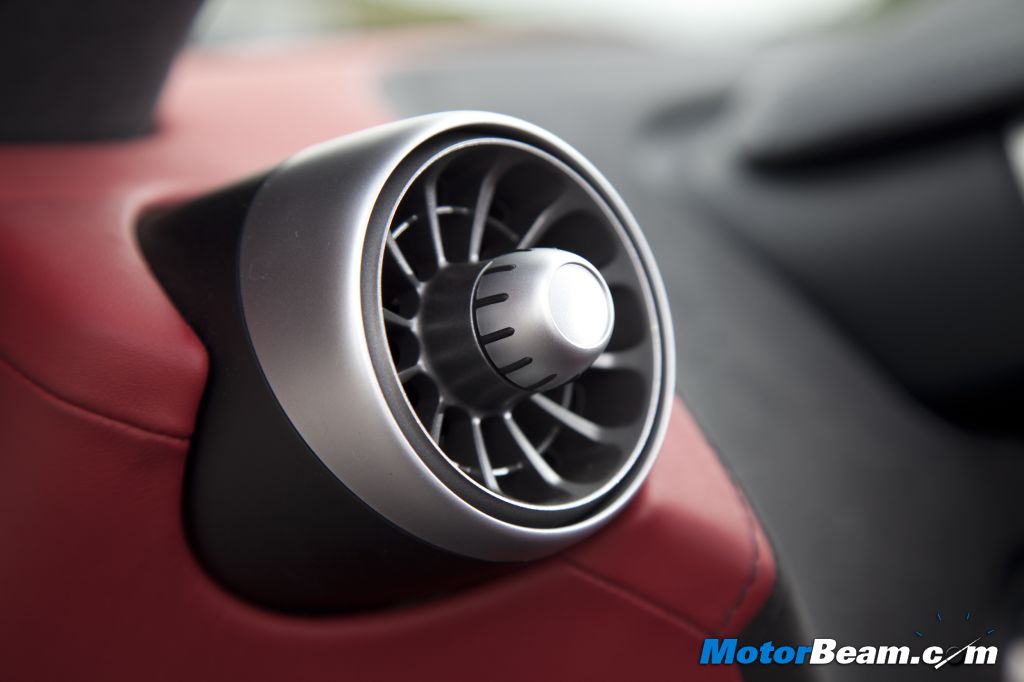McLaren MP4 Review
Car tested: 2012 McLaren MP4 12C
Price OTR Mumbai: Rs. 100,000,000 (est.)
Lewis Hamilton has arrived in India, all set to burn some rubber on the streets of Mumbai. We can’t drive the McLaren F1 car, so we went for the next best thing, the McLaren MP4-12 supercar. The UK-built 2012 mid-engined McLaren MP4 12C is a completely new entrant in the world of supercars from every point of view – engine, design, aerodynamics, handling, instrumentation and ergonomics. It is also a car that is capable of giving the traditional toppers in the segment – Ferrari, Lamborghini, Audi, BMW or Mercedes-Benz and their respective in-house tuning set-ups sleepless nights.
McLaren began the whole exercise with a name for the car in a unique fashion. In the MP4-12C’s nomenclature, ‘12’ relates to its performance level and ‘C’ to its body style. The low slung car is 4509 mm long on a wheelbase of 2670 mm and is 1908 mm wide. In its construction, instead of using an aluminum space frame or unibody, central to this car is a lightweight 105 kgs carbon fibre tub (similar to the SLR). While aluminum subframes hold the engine, suspension and ancillaries, the integrate structure also helps provide a top class safety set-up. Te reduce weight, body panels are made in aluminum or resin composites for easy repair.
Besides its wind tunnel influenced design and scissor doors, what we liked about the design of the rear-engined car is its stance, proportions and profile. It is compact with perfectly contoured organic shapes underscoring the concepts of simplicity, efficiency and lightness that inspired the project. The front features a single opening for the front grille and side air intakes, with aerodynamic sections and profiles designed to direct air to the coolant radiators and the new flat underbody. Unlike the Ferrari 458, there are no small aeroelastic winglets which generate downforce at the front end, however, there are very large radiator inlets either side of the body’s which cut drag, cool engine and brakes. The car’s styling and profile is capable of handling downforce to the extent of 140 kg at 200km/h and beyond.
The scissor doors of the 2012 models are touch sensor operated. Getting in and out of the car is no different than cars with similar cockpit arrangements such as the Mercedes SLR or SLS. Once you drop into this car, a business-like leather bound and carbon fibre trimmed cockpit awaits inspection. The driving position is straight and comfortable, the flat bottomed steering wheel is small and relatively thin-rimmed – the same thickness as on a McLaren Formula 1 car and is biased towards the centre of the car. The dashboard has minimal depth and a large 9000 RPM tachometer surrounded either side by LCD screens which display all sorts of driver-oriented information dominates the upper half. For a change, here’s a steering wheel unburdened by switchgear, but comes with a central-pivoting shift paddle. The leather and faux suede are sewn to high Savile Row standards. Practical features include boot space up front.
However, the most impressive part of the cabin is the intelligently arranged centre console which hosts a big red button to fire the engine, a single knob to set handling parameters and a second knob to adjust powertrain character and five logically positioned single-function buttons. The less critical controls are positioned out of the action zone on column stalks.
For the first time, McLaren has set about creating its own engine with some specialist help from Ricardo which designed and engineered a 3.8-litre, twin-turbocharged, flat-plane crank V8 [internal code M838T] capable of generating 592bhp at 7,000rpm and 600Nm from 3,000rpm all the way through to 7,000rpm. With a specific output of 156bhp per litre this longitudinally placed engine provides a class-leading set of figures through its Graziano-designed seven-speed, dual-clutch automatic electronic transmission.
The choice of suspension set-up being different most from its rivals in the car is hardly surprising. Unlike the Lamborghini Aventador which employs F1-inspired pushrod spring shocks, like most cars the McLaren uses coil springs with double wishbones at each end, but the unique feature is that these components are has linked to hydraulic shock absorbers. Using smart sensors and algorithms, the computers can manipulate the performance at each corner by independently altering the pressure in order to resist and minimize roll and pitch. As a result, the requirement for separate anti-roll bars is redundant out here. As standard, McLaren fits steel discs brakes while high performance carbon-ceramic discs are optional.
Driving impressions – While we traveled all the way to Bahrain for this test report, track driving wasn’t included in the agenda and the exercise was more focused on day-to-day usability of this supercar. You fire up the engine by pressing the starter button in the middle of the console and the turbocharged powerplant roars into life. One of the first things that I noticed was that the car’s 3.8-litre twin-turbo V8 doesn’t sound like a traditional V8 set-up. Despite starting off the drive on a very hot day, I would say the engine note was a lot louder than expected but within minutes of firing the engine seems to settle down to provide a less aurally-intrusive experience.
Before I engaged the electronic gearing – which is similar in operation to an Aston Martin – I had to decide on the chassis set-up along with the drive mode. There were two buttons for this on the central console and I decided to start off the drive with the normal mode as the first few kilometers to be encountered were through Bahrain’s usually congested city roads. In this normal drive mode the car’s behavior is quite basic in the sense that there’s a bit of lag when accelerating. I would rate this as driver-friendly especially around town at slow speeds where the engine is revving at about 1500 RPM and has enough torque to offer as one can comfortable drive it like a normal car without boost and also very deceptive.
Once we cleared the slow city roads and joined the motorway, it was time to change the chassis settings. This as expected can be done on the fly and in track mode combo (the most extreme), the car suddenly seems to wake up from slumber with more than a hint of its blue-blooded intentions. But it’s when the throttle is pushed to about 4000 RPM is when action comes into play as the two turbo chargers kick in. The car’s soundtrack is also more prominent then, typical of a supercar, with an exciting, powerful growl emerging from the engine before it channels through to the exhaust. Special intake sound generators have been designed for different bandwidths – in this case, specific to and complement the three different drive modes.
One has to be a bit careful as at full throttle as a good amount of G-force are generated which slams one into the seat in a time frame less than a blink of an eye. While experiencing the G-forces, the car’s chassis and suspension reciprocate in such confidence that it left me with no alternative but to keep my right foot buried and permit me to do a quarter mile stint in 11 seconds flat. The car’s seven-speed dual-clutch transmission is pretty good in the sense that it is able to cope well with high amounts of torque bursts and there are no niggles with the shift quality as transition between the cogs is completely seamless. For a supercar, the gear shifts are painfully slow in normal mode. I felt the equation of the normal mode should have started with the sport mode.
One of the things I liked about the car’s handling was the feedback from the hydraulic-assisted speed sensitive power steering. It is direct and genuinely driver-friendly and when taking a fast corner the steering makes its presence felt with no kickback or rack rattle – just pure feedback and perfect weighting besides extremely rapid turn-in performance. Instead of two independent levers, the paddles are made from a continuous billet of metal with a common base and because of this arrangement as you pull up on the right paddle, you can feel the left paddle pushing back. But the key purpose for this is clear: there won’t be any accidental shifting in this car.
In normal day-to-day driving, the car’s lowered suspension and low centre of gravity ensures a planted ride, but one does have to be careful when going over speed bumps. McLaren’s expertise in suspension design and management shows up quite admirably, although the set-up is quite unusual. The McLaren MP4 12C’s suspension is coil-sprung with cross-linked hydraulic dampers and there are no sway bars and this gives it the suppleness during the ride which is remarkable for a supercar. The MP4 has two special weapons found in no other supercar and can claim some superiority is quite evident when its hydraulic suspension inhibits body roll with a go-kart’s agility and the rear spoiler which springs in to attention during hard braking.
Among the driver aids in this car is the fact that is appreciated most by it track-oriented owners that the traction control system can be fully deactivated by pressing the Active button on the central console. We did this briefly on the motorway to checkout whether we could trick the car to overcome the grippy large and wide rear Pirelli PZeros. It is possible to swinging the rear sideways with a calculated downshift manouevre and remarkably is the fact that a small and precise amount of counter steer is just needed to get the car back in line. The message: the car is engaging and controllable.
But what is funny sometimes is when you look into the rear view mirror when the car is at speeds especially when the rear spoiler pops up – the view is blocked. However, as we are aware for this car besides ensuring downforce is maintained optimally, it also has the job of acting as an airbrake. The system is also programmed to brake the inside rear wheel during cornering to counter-act any possibility of understeer. For the few hours that we were with the car, there’s no doubt that the MP4 12C’s limits are way beyond anything you can actually do on a public road. It’s also one of the reasons that both the powertrain and suspension have three settings each – Normal, Sport and Track and driver specific combos.
At its limit the 12C will showcase mild understeer, but in a car with enormous torque, there’s a limited-slip differential to help counter it. While the car has an open differential and relies on electronic nannies to do this work but, in real time, one has to have a very heavy right foot to drive through the understeer situation. While, the McLaren in general has an adjustable temperament, it’s would like to do things its way and sometimes that interference can spoil the kill.
Verdict – With the forthcoming revisions, the MP4 12C should be able to garner more support and appreciation from its followers and new owners. Unlike Ferrari which created the California for drivers requiring a more versatile sports car with a practical edge and the 458 Italia for owners for whom the priority was uncompromising on-road performance with occasional track day capability, McLaren have been able to roll in both these aspects in one car. The current production capacity in UK is for 1,500 units and a sizable portion of this allocation is headed towards Middle East. With the new infrastructure and retail partners in place in strategic locations in the region, McLaren should be able to make a dent in this section of the market with confidence.







